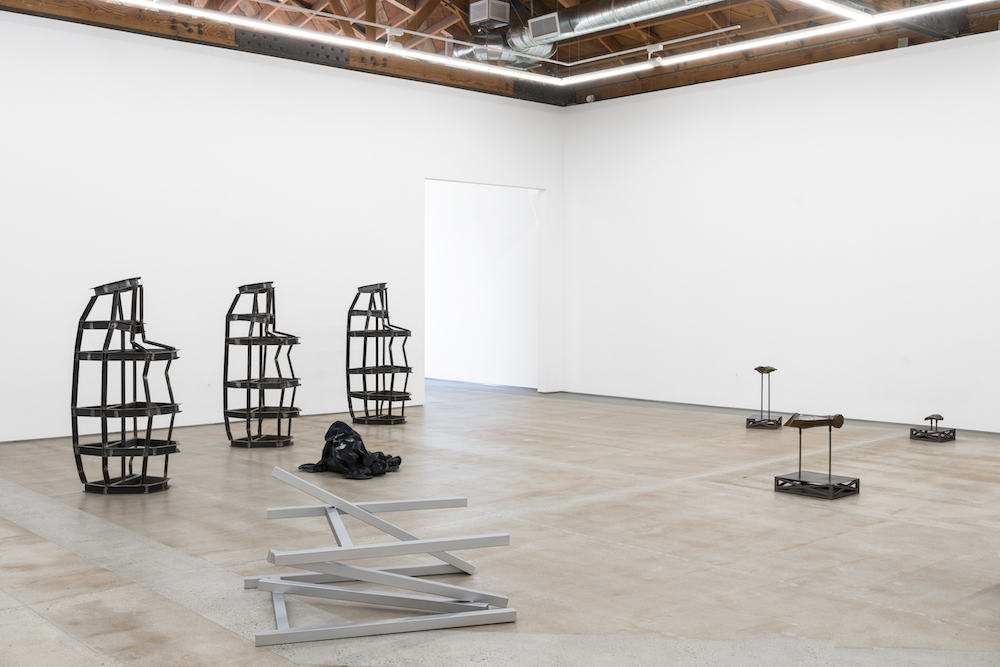In her still-young career, Aria Dean has shown a remarkable knack for giving the institution exactly what it wants: shrewd work that stings the nerve of the moment without quite stabbing it. In activating the virtual as a conduit for Black radical thought, Dean’s interests dovetail nicely with the art establishment’s current (though fading) focus on political and identity orientation, as well as its recent (though tepid) embrace of post-internet work.
What Dean gives us in “Facts Worth Knowing,” however, is a significant departure. What she gives us is an artist on strike.
Up to this point, Dean’s output has been explicitly tied to Blackness, Afropessimism, and racial capitalism. Yet there’s no mention of any of that here, which is curious given the show’s association with Intolerance, D.W. Griffith’s 1916 epic. (Yes, that Griffith of Birth of a Nation notoriety, once the father of American cinema, now its maligned racist uncle). Instead, Dean, via the show texts, tells us to consider minimalism and form and the perception of sculpture in space and time (recalling Robert Morris’s 1966 “Notes On Sculpture”). These currents crested in importance in the Minimalist era with artists almost exclusively white and male, now old or dead.
Dean’s omission of Blackness from her own show—at least in its expected, explicit form—is the nexus on which things turn. In other words, Blackness is (drumroll) the elephant in the room, and Dean acknowledges this by fragmenting, warping, and melting an elephant out of a discontinuous montage of black steel and bronze. She models her elephant, or the sum of its parts, off of portions of Griffith’s monumental (and notoriously abandoned for years on an East Hollywood lot) Intolerance set, using blueprints from the set’s appearance in the 2011 video game L.A. Noire to help accurately render her forms. Notably, that video game takes place in 1947, almost thirty years after Griffith’s set was razed. To add it all up, then: We’ve got a deconstructed representation of an elephant, modeled off of a digital facsimile of a replica of a statue of an elephant, from a time in which it never existed in a place that doesn’t exist (or exists only virtually).
Remember, though: You’re here to think about material, the text says, and temporality, and space. So, you try. You think about steel which structures, bronze which historicizes, both of which are certain and fixed. You note that the titles of the first three pieces, the Duchampian Bottle Rack-esque sculptures near the entrance, all mention armature or infrastructure or both, and, naturally, you wonder what exactly they’re armatures and infrastructures for. They’re implied frames, supports for real, true sculpture—the everlasting—yet within the frame of the gallery they exist as real, true sculpture themselves, simply because they’re here. Thus, the negatives that affirm the absent positive become the positives themselves, and the distinction between object and subject begins to slip, as does the consensus on which that distinction is built. Dean echoes this in the formatting of her exhibition essay, printed with a conspicuous border around the text, leaving the title of the show outside that frame, yet within another, hinting that the facts worth knowing in “Facts Worth Knowing” exist both ex- and in-frame.
Primed to think about the impossibility of the frame, we can read this work as Dean denying the establishment the conveniently packaged, readable show it wants, while alluding loudly to its absence. There’s a chance “Facts” is still on some level cynically catering to museum boards, the institutional darling engineering a rebellious streak. Or maybe it’s more of a newfound artistic obstinacy, an inversion of, say, Mike Kelley’s sardonic embrace of the apparatus’s expectation. More likely, though, Dean just came to realize that the work was starting to produce her, and she wanted out. No matter, the institution will happily devour this show, just as capitalism devours its discontents only to respawn them as commodities. It’ll find a frame, as it always has done—a frame that will, once again, limit the work, as it has always done.
Dean’s project here—the larger one, the strike—is a gesture at unlimiting. By questioning the productive relations of the art world, and in trying to avoid becoming synonymous with herself, she reminds me more of Michael Krebber, the (white) German conceptual painter, than anyone else. Krebber’s current show at Greene Naftali comes accompanied by a text that argues in favor of artists who seek rather than find. The latter is more passive, at times intuitive, and certainly yields fine results, but the text stresses that seeking—through its almost unsexy manifest of the attempt, of the unfinal—opens us to ideas about “where [art] comes from and what it is after.” Measured this way, Dean’s show reads an expansion of the field of art for art’s sake, an insistence on the uncertain terms that make art art.


